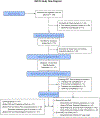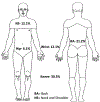Chronic pain is associated with a brain aging biomarker in community-dwelling older adults
- PMID: 31009418
- PMCID: PMC6752890
- DOI: 10.1097/j.pain.0000000000001491
Chronic pain is associated with a brain aging biomarker in community-dwelling older adults
Abstract
Chronic pain is associated with brain atrophy with limited evidence on its impact in the older adult's brain. We aimed to determine the associations between chronic pain and a brain aging biomarker in persons aged 60 to 83 years old. Participants of the Neuromodulatory Examination of Pain and Mobility Across the Lifespan (NEPAL) study (N = 47) completed demographic, psychological, and pain assessments followed by a quantitative sensory testing battery and a T1-weighted magnetic resonance imaging. We estimated a brain-predicted age difference (brain-PAD) that has been previously reported to predict overall mortality risk (brain-PAD, calculated as brain-predicted age minus chronological age), using an established machine-learning model. Analyses of covariances and Pearson/Spearman correlations were used to determine associations of brain-PAD with pain, somatosensory function, and psychological function. Individuals with chronic pain (n = 33) had "older" brains for their age compared with those without (n = 14; F[1,41] = 4.9; P = 0.033). Greater average worst pain intensity was associated with an "older" brain (r = 0.464; P = 0.011). Among participants with chronic pain, those who reported having pain treatments during the past 3 months had "younger" brains compared with those who did not (F[1,27] = 12.3; P = 0.002). An "older" brain was significantly associated with decreased vibratory (r = 0.323; P = 0.033) and thermal (r = 0.345; P = 0.023) detection, deficient endogenous pain inhibition (F[1,25] = 4.6; P = 0.044), lower positive affect (r = -0.474; P = 0.005), a less agreeable (r = -0.439; P = 0.020), and less emotionally stable personality (r = -0.387; P = 0.042). Our findings suggest that chronic pain is associated with added "age-like" brain atrophy in relatively healthy, community-dwelling older individuals, and future studies are needed to determine the directionality of our findings. A brain aging biomarker may help identify people with chronic pain at a greater risk of functional decline and poorer health outcomes.
Figures









Similar articles
-
Accelerated Brain Aging Mediates the Association Between Psychological Profiles and Clinical Pain in Knee Osteoarthritis.J Pain. 2024 May;25(5):104423. doi: 10.1016/j.jpain.2023.11.006. Epub 2023 Nov 10. J Pain. 2024. PMID: 37952863 Free PMC article.
-
Age and pain differences in non-verbal fluency performance: Associations with cortical thickness and subcortical volumes.Exp Gerontol. 2019 Oct 15;126:110708. doi: 10.1016/j.exger.2019.110708. Epub 2019 Aug 21. Exp Gerontol. 2019. PMID: 31445107 Free PMC article.
-
Altered Endogenous Pain-Inhibitory Function in Older Adults With Chronic Pain Is Associated With Disruptions in Functional Connectivity During Resting State.J Pain. 2024 Nov;25(11):104641. doi: 10.1016/j.jpain.2024.104641. Epub 2024 Jul 17. J Pain. 2024. PMID: 39029880
-
Magnetic resonance imaging for chronic pain: diagnosis, manipulation, and biomarkers.Sci China Life Sci. 2021 Jun;64(6):879-896. doi: 10.1007/s11427-020-1822-4. Epub 2020 Nov 23. Sci China Life Sci. 2021. PMID: 33247802 Review.
-
Improving the understanding and management of back pain in older adults: the BOOST research programme including RCT and OPAL cohort.Southampton (UK): National Institute for Health and Care Research; 2023 Nov. Southampton (UK): National Institute for Health and Care Research; 2023 Nov. PMID: 38127693 Free Books & Documents. Review.
Cited by
-
Persistent Non-pharmacological Pain Management and Brain-Predicted Age Differences in Middle-Aged and Older Adults With Chronic Knee Pain.Front Pain Res (Lausanne). 2022 Jul 12;3:868546. doi: 10.3389/fpain.2022.868546. eCollection 2022. Front Pain Res (Lausanne). 2022. PMID: 35903307 Free PMC article.
-
Accelerated brain aging in chronic low back pain.Brain Res. 2021 Mar 15;1755:147263. doi: 10.1016/j.brainres.2020.147263. Epub 2021 Jan 7. Brain Res. 2021. PMID: 33422525 Free PMC article.
-
Joint Pain and Leisure-Time Physical Activity: Cross-Sectional Findings From the Cardiovascular Health Study.Health Sci Rep. 2025 Feb 12;8(2):e70367. doi: 10.1002/hsr2.70367. eCollection 2025 Feb. Health Sci Rep. 2025. PMID: 39949522 Free PMC article.
-
Pain and the Montreal Cognitive Assessment (MoCA) in Aging.Pain Med. 2021 Aug 6;22(8):1776-1783. doi: 10.1093/pm/pnab003. Pain Med. 2021. PMID: 33718961 Free PMC article.
-
Prevalence and Sociodemographic Correlates of Chronic Pain Among a Nationally Representative Sample of Older Adults in the United States.J Pain. 2024 Oct;25(10):104614. doi: 10.1016/j.jpain.2024.104614. Epub 2024 Jun 25. J Pain. 2024. PMID: 38936750
References
-
- Cohen J Statistical power analysis for the behavioral sciences. Academic Press, 1977. p.
Publication types
MeSH terms
Substances
Grants and funding
LinkOut - more resources
Full Text Sources
Medical
Miscellaneous

